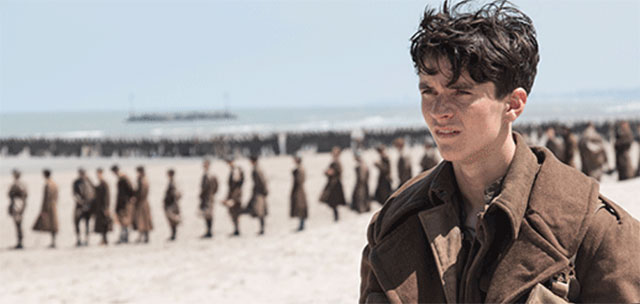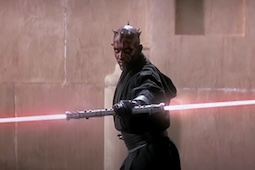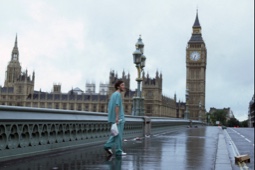
We're counting down to the release of Oppenheimer by looking back at Christopher Nolan's movies in order.
The director's latest project is a typically secretive affair, tracing the development of the atomic bomb. Cillian Murphy plays J. Robert Oppenheimer, the man who sent humanity careering in a dark new direction, and the remarkable supporting cast includes Emily Blunt, Matt Damon, Florence Pugh and Robert Downey Jr.
Clad in fiery vistas that herald the birth of brand-new 20th-century warfare, Oppenheimer is poised to be a feast for the senses and the emotions. Nolan splits the aesthetic of the movie between timeline and colour, promising a truly epic delve into an epochal moment in human history. As expected, Nolan has captured the movie on IMAX cameras, resulting in apocalyptic sequences that promise to take the breath away.
This week, we're discussing Nolan's World War II thriller Dunkirk.
What’s the story of Dunkirk?
May, 1940: Allied troops are under threat of being cut off by Nazi forces on the French beach of Dunkirk. Three narratives unfold across land (one week), sea (one day) and air (one hour), as Operation Dynamo takes shape, the audacious mission to bring British soldiers back to home soil.
On the beaches, young private Tommy (Fionn Whitehead) and his fellow recruits must survive relentless strafing raids from the German Stukas. On the sea, a flotilla of civilian vessels set off from the coast of southern England to intercept and rescue those in danger, including one piloted by Dawson (Mark Rylance). And in the air, fighter pilot Farrier (Tom Hardy) engages with German bombers to buy time for those below.
This rescue mission would prove to be a turning point in World War II history.
How did Dunkirk get made?
Fact-based wartime thriller Dunkirk is perhaps the apex of Christopher Nolan’s time-meddling experiments. In the wake of the grandiose The Dark Knight Rises and Interstellar, Nolan brought everything back to the non-linear, experimental style of his breakout hit Memento. Released in 2000, Memento cemented Nolan’s love of time as a fluid, amorphous, profoundly subjective experience, relaying the story of one man’s struggle with short-term memory loss.
That same principle also informs Dunkirk, which shows a desire to fracture temporal perception into a million pieces. The movie strips all notions of jingoism and patriotism out of the equation to form a three-pointed narrative that spans one hour, one day and one week. Far from being a gimmick, Nolan uses this device in a powerfully emotional way, examining how heroism and valor isn’t relative to the time in which it takes place. In the world of Nolan’s Dunkirk, one man’s hour is the equivalent to another man’s week, which is further aided by the way that the timelines repeatedly criss-cross.
Take Tom Hardy’s noble fighter pilot Farrier, for instance. His time spent in this particular arena of conflict is the shortest experienced by any of the film’s characters. Yet what he achieves within the space of that hour, strafing and bring down enemy craft, has a profound impact on everyone else perceiving the battle in terms of days and weeks. In the end, time is revealed to be an almost incidental construct, dissolved by the rigorous, unerring desire to perform one’s duty. It’s an unspoken code that emotionally bonds the film’s various characters together, even as they’re physically separated by temporal space.
Such themes were previously put forward, to much more clunky, expositional effect, in Nolan’s Interstellar (2014), with its dialogue about “love transcending time”. In the case of Dunkirk, however, exposition is kept to a minimum, with the sheer physicality of the production and the terrifyingly oppressive sound design acting as its own form of dialogue.
Of course, Farrier could be seen as an avatar for Nolan himself, a craftsman with exacting demands who pursues seemingly impossible tasks and wins the admiration of those around him. That Nolan got to make Dunkirk on his own terms is a direct result of the trust he had built up with studio Warner Bros, a partnership that had resulted in a near-unbroken stream of critical and commercial hits. Surely no director other than Nolan would have been given the green light to fashion an experimental, non-linear World War II movie, based on true events, in which Americans are notable by their absence.
The story was an intensely personal one for Nolan, who recalled the memories of his grandfather: "My grandfather was in the Air Force,” he said. “He did not participate in Dunkirk; he was a navigator in Lancaster and he died in the war." He adds: "I try to only make films that I feel very connected with on some emotional level. This is the first time I’ve taken on a real-life event, and there’s a huge responsibility that comes with that. But I suppose in some ways feel more personal."
As with the earlier Interstellar and Inception (2010), Dunkirk was a huge gamble, even from a filmmaker with a proven track record. Nolan was trusted with a $100 million budget to make the movie, hefty, but considerably less than the cost of his two prior blockbusters, each of which reached upwards of $200 million when marketing costs are considered. In stark contrast to his earlier movies, Nolan put most of the plot-propelling dialogue to one side, allowing the cavernous IMAX cinematography to put the actors (and, by extension, the viewing audience) in the heart of the conflict.
Once again averse to using CGI, Nolan favoured practical effects to bring tactile realism to Dunkirk. This involved filming on location on the actual beach, and equipping real Spitfire bombers with IMAX cameras. The latter proved a challenge for cinematographer Hoyte van Hoytema, returning from Nolan’s Interstellar, who raced to keep up with the director’s vision. Hoytema described his intention for the movie as "virtual reality without the goggles", and in fact shot a staggering 75% of the movie in the IMAX format.
Hoytema told Deadline: "The... cameras are very clumsy, but we definitely agreed that that format would be best. So for us, it was all about overcoming all the practicalities around it. How can we make this camera more mobile? How can we put it on the shoulder? How can we do quick reloads? How can we dip it underwater? How can we put it on the wing of an airplane? "Then, it became a lot about engineering. We engineered and designed lenses for the camera that could look around corners and were more light-sensitive than the older ones, or had closer focus. It was a long trip of engineering and doctoring in order to make it work, but the fact that we wanted to make it work was a given from the beginning."
Hans Zimmer’s score is another key character in the drama, a monstrous, writhing contortion of dissonant effects that more often than not approximate sound design rather than music. Zimmer deploys a ticking effect, a la Interstellar, to ruthlessly give the sense of hope ebbing away, and he also deploys a device known as the Shephard Tone. Named after Roger Shephard, the near-constant use of ascending and descending pitch has a discombobulating effect on the viewer, relentlessly lapping at and battering them in the manner of the waves engulfing the Dunkirk mole (the breakwater). Or, perhaps more appropriately, in the manner of an encroaching Stuka, whose droning presence becomes as terrifying as anything in a horror movie.
Likewise, the casting seeks to defy the usual star-studded conventions of war movies. Nolan sought to cast actors similar in age to those involved in the real-life Dunkirk conflict. Newcomer Fionn Whitehead is effectively frazzled as Tommy, and would enjoy a star-making role that would propel him to the later likes of Black Mirror: Bandersnatch. Other up-and-coming actors would also make their name in the movie, including Barry Keoghan (The Killing of a Sacred Deer) and Jack Lowden (Fighting with my Family).
Even the film’s most famous faces are perhaps best appreciated as A-list character actors, rather than the conventional Hollywood likes of Brad Pitt. It’s all the better for immersing us in the world of the movie. Kenneth Branagh plays Commander Bolton, tasked with getting the soldiers on the boats away from the mole, Cillian Murphy is a traumatised individual known only as ‘Shivering Soldier’ and the aforementioned Tom Hardy plays Farrier. (Nolan’s good-luck charm Michael Caine is heard on the radio as Farrier’s superior officer.)
Perhaps the most famous face (depending on the age of the person you’re talking to) is former One Directioner Harry Styles as a soldier stranded on the beach. Style’s casting was greeted with some derision at first, seen as nothing more than a cynical stunt designed to entrap young audiences. Whether that had an effect or not is unclear, but he’s surprisingly convincing and merges well with the rest of the ensemble. One must credit Nolan with stripping away Styles’ familiar persona and framing him in a matter-of-fact manner so that he doesn’t distract from the wider drama.
Yet ultimately, it’s not the technique of Dunkirk that wins us over but its heart. Everything comes home to roost in the stirring final sequence, set to Benjamin Wallfisch’s reworking of Elgar’s classic ‘Nimrod’. Form and content merge to perfectly illustrate Nolan’s philosophy, as we intercut between Tommy’s return to the UK, and Farrier’s landing on the beach at Dunkirk, where he’s subsequently captured by the Germans. The two events are occurring on different timelines, yet Nolan and editor Lee Smith intercut them to make it seem as if everything is happening concurrently.
In an emotional sense, that is exactly what’s happening: the reason why Tommy is sitting where he is stems from Farrier’s brave sacrifice. One man’s actions in a particular timeline have had a direct bearing on those in another, the two characters bridged even though they’ve never met face to face. We all experience time in a deeply personal, subjective way, yet there are far more powerful impressions that cut through those divides, uniting the human race with an invisible cord.
When set to the words of Winston Churchill’s famous “we shall never surrender” speech, it becomes quite possibly the most profound moment in Nolan’s filmography.
How was Dunkirk received?
Dunkirk achieved critical acclaim. The New York Times described is as "both sweeping and intimate", adding: "It’s a characteristically complex and condensed vision of war in a movie that is insistently humanizing despite its monumentality, a balance that is as much a political choice as an aesthetic one."
Many other reviewers were similarly effusive. Time lauded it as a "masterpiece", observing: "Its visual and sound effects are elaborate and impressive. This is a grand spectacle, not an empty one, a rare example of the Hollywood blockbuster dollar well spent. Dunkirk is extraordinary not just because it’s ambitious and beautifully executed, but because Nolan, who both wrote and directed it, has put so much care into its emotional details—and has asked so much of, and trusted, his actors."
Even more significantly, Dunkirk also proved to be a box office success, grossing $500 million against its $100 million budget. This was certainly not guaranteed given the lack of an American stake in the storyline. With the American market so key to the success of Nolan’s films, was he asking too much for the Yanks to invest in a long-forgotten (to them) section of World War II history?
It turned out that wasn’t the case at all. Audiences around the world were hungry for Dunkirk, no doubt propelled by Nolan as a brand name. By this stage, the director had repeatedly traversed that seemingly impassable divide between critical acclaim and box office gold, capable of captivating both the reviewers and the popcorn-craving blockbuster crowd. It was surely this awareness of Nolan’s brand that helped propel Dunkirk to success, winning over those with minimal interest in the true story.
Once again, Nolan had taken a property that could so easily have been impersonal and injected it with grace notes of his own personality and intelligence. History was made at the 2018 Academy Awards when Nolan received his first Oscar nomination for Best Director, having been shockingly overlooked for the earlier likes of Memento, The Dark Knight (2008) and Inception. Finally, everything had come together: reviews, box office and artistic prestige, although Nolan would ultimately lose the trophy to Guillermo del Toro for The Shape of Water.
Much like the characters in the movie, Nolan had faced seemingly impossible odds and succeeded, fashioning a wartime movie with contemporary relevance. It was another step towards him becoming the most feted Hollywood director of modern times.
What was Nolan's next movie?
Nolan's next movie was Tenet, released in 2020.
Oppenheimer is scheduled for release on July 21st. Click the link below to get your tickets and let us know what your favourite Christopher Nolan movie is @Cineworld.











.jpg)


.jpg)
.png)






